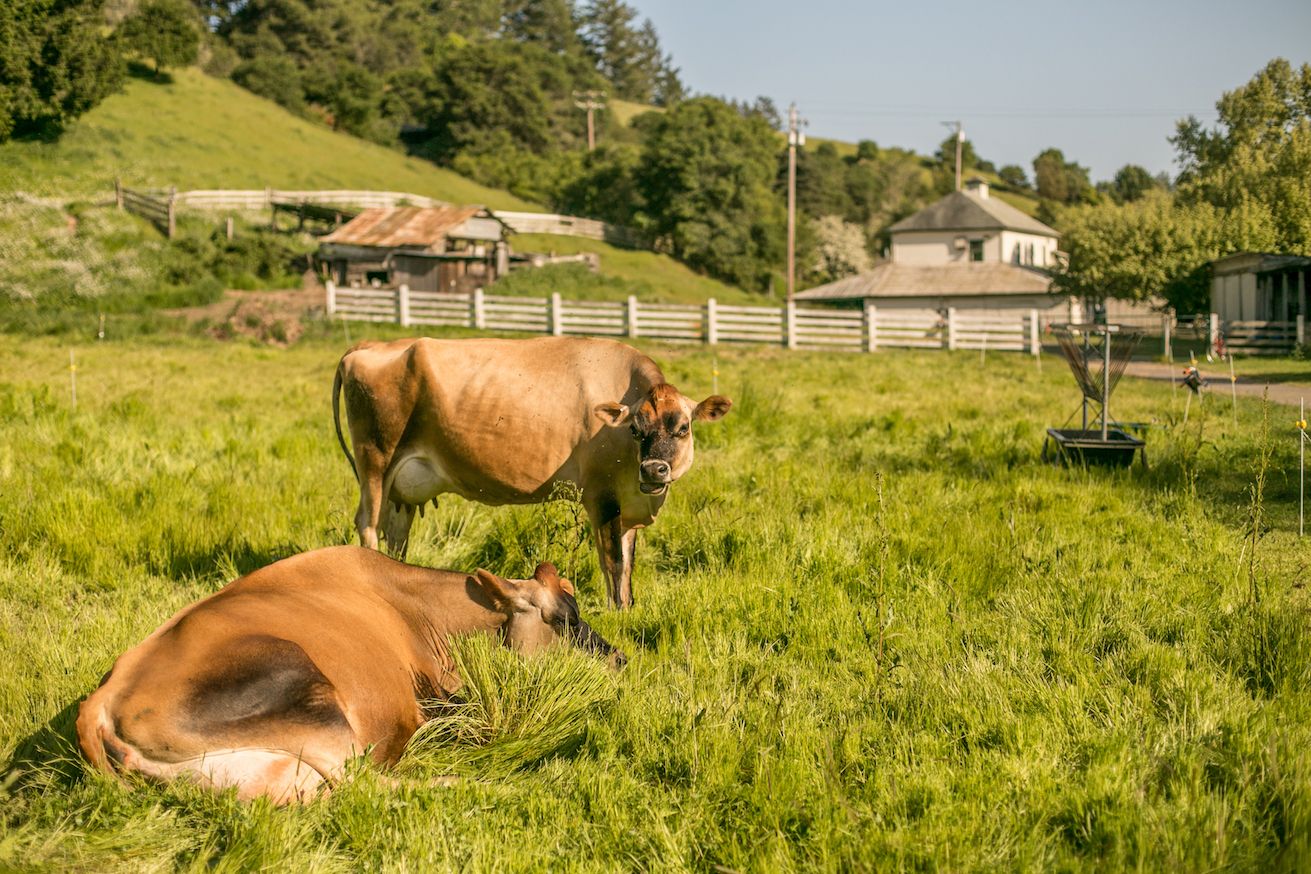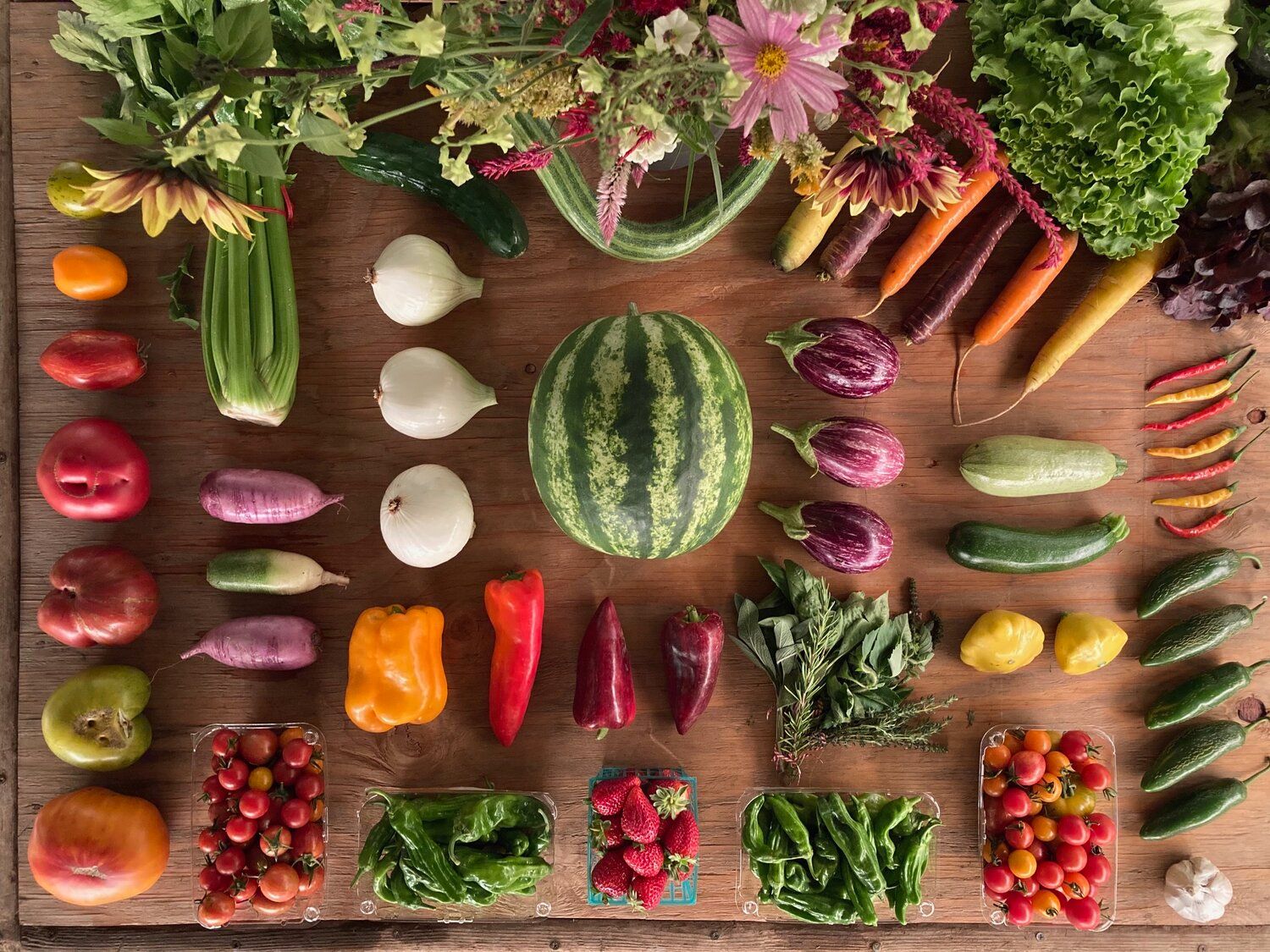
Regenerative Farming Put to the Test: Voices from Small Scale Farmers on Drought, Climate Change
The West Coast of the US is in an unprecedented drought, casting doubt as to how our agricultural systems can survive in the new normal of climate change. Regenerative small-scale farming is leading the way in resilience and innovation in farm jobs and food systems.
The West Coast of the US is in an unprecedented drought, casting doubt as to how our agricultural systems can survive in the new normal of climate change. Regenerative small-scale farming is leading the way in resilience and innovation in farm jobs and food systems.
Outline
When do we need to move the cows? How much water did we use today? How’s our soil moisture feeling? Do we need to add more compost or mulch? These questions are at the top of the mind for farmers Aubrie Maze, Elizabeth and Paul Kaiser, and David Bill and Faith Van De Putte. As practitioners of the regenerative farming movement, their farms in California and Washington implement climate friendly practices both as a contribution to climate solutions and as a nutritious food source for their communities. We’ll learn from each of these farmers how they are sustaining and innovating on their operations this year, and what non-farmer roles support their work.
What is Regenerative Farming?
Regenerative farming is a broad term that encompasses solutions like rotational grazing, compost application, no or low tillage operations, crop diversification and silvopasture. While these may all seem very different, what they all have in common is an emphasis on building soil health through deeper root systems and diverse soil microbiology-- which also drives positive impacts in soil organic matter and soil carbon. This all translates to healthier land, lower environmental impacts, and increased opportunities for using agriculture as a climate solution by drawing down carbon from the atmosphere and storing it in the soil.
When the wildfires rage on the West Coast, the principles of regenerative farming can help mitigate the destruction. Having deep root systems, below-ground carbon storage, and life in the soil helps mitigate the destructive impacts, which is important to farmers as a means to protect their businesses and land as climate change drives fires to become more and more frequent and intense. There are no “silver bullets” to avoid or erase climate impacts in small-scale farming, but having life in the soil certainly helps.
What do Careers in Regenerative Farming Look Like?
Given the climate solutions that these farmers are all exploring, innovating on, and educating about, what opportunities do they see for more careers, partnerships, and work opportunities in regenerative agriculture? Myriad. There is a consensus that more people, with various diverse skill sets, are needed to come together and collaborate on scaling proven solutions: farmers to try out practices in different contexts and make locally relevant modifications, researchers to design experiments and analyze the data, chefs to tell the story of climate-informed ingredients via delicious consumable creations, storytellers to better communicate the nuances and complexity of ‘regenerative agriculture,’ entrepreneurs to build new companies and products with a realistic farm-informed perspective, and urban planners or architects to re-envision the built environment as an inclusive space for decarbonization, food production and healthy human communities. So, being a skilled data analyst, marketing/communications professional, digital designer, or design thinker could land you squarely in the circle of demand for workers supporting sustainable and regenerative food system transformation.

Small scale farming is diverse, and each farm in the Terra.do Farm School network offers insights into regenerative farming as well as farm jobs of the future. Each of our host farms highlights their own on-farm view of challenges and opportunities for farming regeneratively amidst intensifying climate impacts, as well as approaches for solutions and opportunities within the field.
Singing Frogs Farm: Positive Externalities in Regenerative Farming
Just outside the town of Sebastopol, CA, Elizabeth and Paul Kaiser of Singing Frogs Farm are leaders of the biointensive no-till management system for vegetable production, which they have popularized through the many conference talks and workshops they have led for audiences all over the world. They are farming profitably on less than 3 acres of fields of an 8 acre farm, and are noticing that everything is not as bad as it could be in their veggie fields this year. True, they have better access to water resources than some nearby farms, but the focus on building the soil is what’s truly helping them stay afloat this year financially. According to Elizabeth, “for a long time, we were thinking about mitigation. It really only became apparent maybe 3 years ago that the things we’re doing to mitigate are helping us farm in the face of climate chaos, also. We made a shift in talking: about how you CAN sequester carbon while growing veggies (you can, and we are, and now others are too), to how your carbon sequestration also makes you more resilient to climate impacts [like drought, wildfire season, heat waves, etc.].” The fires here in Northern CA started shifting things for Elizabeth and Paul. People were asking all of a sudden “how are you dealing with this?” and they found themselves saying, “it’s the same things we’ve been doing: cover the soil, maintain biodiversity.”’ When asked if they see their farming practices as more about climate mitigation or adaptation, they can’t choose. How can you have a farm that is environmentally sustainable but not economically? How can you have a farm that is mitigating climate change but not adapting to it? Adaptation and mitigation are working hand in hand, essential sides of creating resilient systems.
Elizabeth offers some words of wisdom to aspiring farmers and food system entrepreneurs: “Economic activities have ‘externalities,’ so how can businesses have positive externalities? If you farm well and sequester carbon and grow healthy food, there are positive externalities. Crop diversity helps you if one or two crops fail and you’re needing more resilience. Creating resilient systems that work with Mother Nature and have positive benefits, not acting like a reductionist in/out equation, is the kind of farming work we need.” Can farmers start to be paid more for these positive externalities? That remains a question for innovative entrepreneurs and policymakers, who will hopefully start to see positive externalities holistically rather than single-mindedly focus on carbon and carbon markets as the only way to pay farmers for their ecosystem services.
Climate career takeaway: For climate minded entrepreneurs, investors, and policymakers re-addressing investments and fiscal externalities in light of climate change, regenerative farming offers a growing field of investments and opportunities that offer profit and purpose.
Read: How to Navigate Climate Finance and Climate-Resilient Investments
Learn more with: Climate Change for VCs
Green Valley: Drought and Diversification in Small Scale Farming
A few miles from Singing Frogs, Aubrie Maze runs a rotational grazing system in the herdshare she manages at Green Valley Farm + Mill with her partner, Scott Kelley. They are constantly seeking to improve the health of their pastures, but they have been dealing with incredibly difficult circumstances this year: “we’ve needed to purchase supplemental feed throughout the year as we have not been able to rely on pasture grasses alone to feed the herd due to the extreme drought conditions in Sonoma County, and it’s been really challenging to drive electric fencing rods into the rock hard ground.” The drought conditions have also forced the decision of their landmates to not grow annual Community Supported Agriculture (CSA) vegetables this year due to lack of water. They are instead relying on diversification within their business, focusing on u-pick flowers, herbs, and berries.
As a whole, the Green Valley team is relying heavily on diversification of activities, crops, feedstocks, and revenue sources to weather the difficult year and sustain the overall health of their farming operations. Conveniently, the Green Valley landmates are very diverse themselves in terms of professional background and skill sets: from foresters, furniture makers, and veggie farmers to event managers, authors, herbalists, educators, and chefs, putting them in the best possible scenario to take on new and diverse business ventures on the land.
Climate career takeaway: Farm jobs don’t fall into one category, and diversification will be even more important as climate change throws curve balls at agriculture professionals.
Read: Interdisciplinarity in Practice as a Climate Change Professional
Learn more with: Climate Change: Learning for Action
Midnight’s Farm: Small Scale Farms As ‘Living Labs’
Up on Lopez Island, David Bill and Faith Van De Putte of Midnight’s Farm are looking into a variety of activities to reduce carbon emissions and add resilience to their already highly diversified 100-acre farming operation on Lopez Island. They rotationally graze cows, pigs, and chickens, grow a ½ acre no-till market garden and berry patch, and produce and sell compost in a Department of Ecology certified facility.
Constant innovators, David and Faith are now exploring silvopasture practices like planting trees and shrubs in their pasture to add shade, another factor that would keep grasses greener longer and keep the animals happier in the increasingly hot summer months (case in point: temperatures on the island recently soared to record highs of over 100 degrees in June during the blistering Pacific Northwest heatwave that broke records everywhere from Oregon to Canada). One last development they’re exploring to reduce the climate footprint of their farming operations: partnering with a start-up company to give their cows a seaweed-based feed supplement that is targeted to reduce methane emissions from ruminant animals.
With all of their experiments, David and Faith seek partnerships to “do the science” and understand the results, all while keeping up the day to day work on the farm. Researchers and data analysts and entrepreneurs take note: where is the regenerative farm near you seeking help to initiate and report back on new practice trials designed to create a better farm carbon balance?
Climate career takeaway: Farm jobs are more and more often found within the world of startups and think tanks; that means that techies, entrepreneurs, and founders are all jobs perfectly poised to take on the challenges of regenerative farming.
Read: What Does it Mean to “Work on Climate”?
Learn more with: the Climate Farm School
Take Action with On Farm Climate Education

The Terra.do Farm School aims to bring many diverse professionals together to build climate resilient food systems from production to consumption to waste disposal as collaborators and partners. Whether you are looking to transition into small scale farming yourself or support others in doing so in your community, this course is an opportunity to up your game as a regenerative agriculture ally.
Beyond this course, the farmers we've highlighted in this article all have a shared faith in the power of human connections and educational experiences to translate what is being learned on the land into actual scalable solutions that mitigate and adapt to climate change across the food system. So, wherever you are, seek avenues to listen and learn from farmers about the climate impacts we’re living through, and gauge their ideas for how we can do better for human health and climate resilience.
Learn more about how you can get involved in the Terra.do Farm School here: https://bit.ly/3fWL2Zz
More like this
So You're Ready to Step Up on Climate Action. Now What?
Folks ready to learn and do more about climate change have an array of options to get started. What are their respective pros and cons, and how does Terra.do stack up?
Our Next Cohort's Nickname Is the Manatees. Here's Why That's Special.
We've named each graduating class after animals at risk in our warming world, and we've just finished our first full lap through the alphabet.
Couldn’t We All Use More Storage?
Where are we going to put all that clean power from variable renewables like solar and wind? The world of batteries is already ramping up.

 Background
Background


